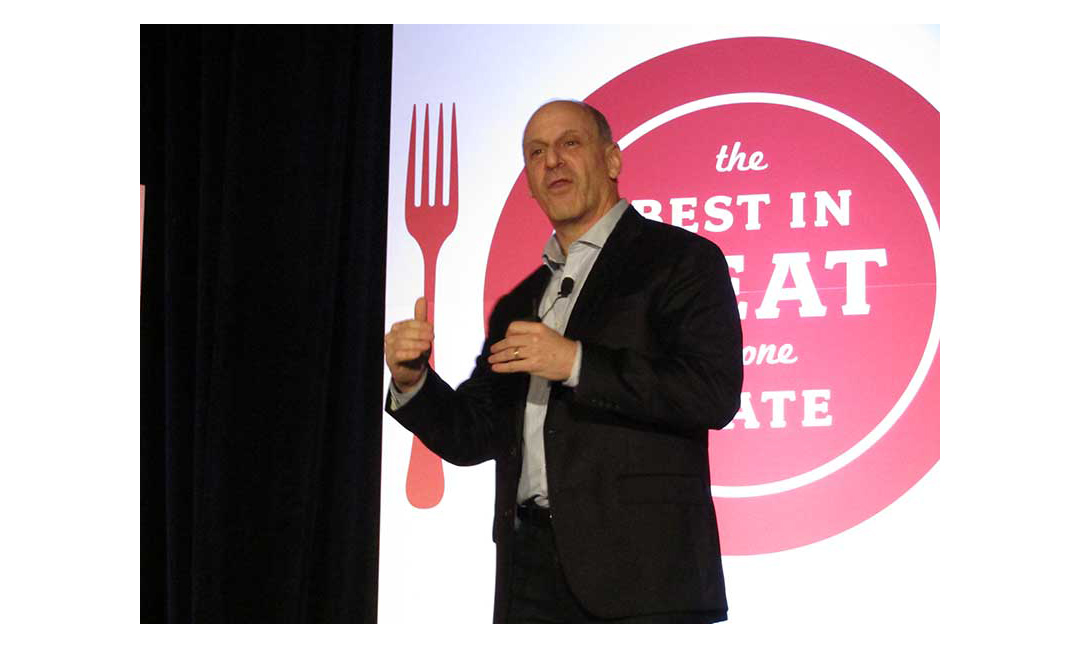Editor’s note: Last month, The Shelby Report published part one of our coverage of a presentation given by Neil Stern, a senior partner at retail consultancy firm McMillanDoolittle LLP, at the Annual Meat Conference entitled “Maintaining Relevancy: Retail Trends Impacting Today’s World and Beyond.” In part one, Stern laid out demographic and consumer behavior trends, threats to traditional grocers and the impact of disruptors like Amazon. Here in part two, Stern discusses the formats that are growing and shares examples from future-looking retailers located across the globe. He also has five questions for all grocery retailers to consider as they contemplate the future.
by Terrie Ellerbee/editor-Southwest
There is good news for grocery retailers as they look ahead to the remainder of 2018. Inflation is picking up. For almost two years, prices in every major food category fell. As an example, the average price of a dozen eggs dropped close to 40 percent between July 2015 and July 2016.
“Honestly, we had never seen anything like it,” said Neil Stern, senior partner at retail consultancy firm McMillanDoolittle LLP. “We’ve had to sell more units just to stay even. In fact, we haven’t stayed even in a lot of categories.”
Stern said the problem is that even as deflation eases, traditional supermarket sales growth will not keep pace with inflation. The sales growth will be in e-commerce sales of food and consumables; they are projected to grow 23.1 percent by 2020. Other channels that will experience growth through 2020 include fresh formats (8.6 percent), limited assortment (7.0 percent) and dollar (4.8 percent). The annual sales growth rate for traditional supermarkets is projected to be just 0.4 percent.
So, what can traditional grocers do to stay relevant? One thing to consider is size. Mass merchandisers are opening smaller stores. Retailers like France’s huge hypermarket operator Carrefour are “almost going back to their roots of trying to be local retailers and small retailers,” Stern said.
“Carrefour has taken the front of their store and they’ve tried to emulate a kind of traditional fresh market that you would see in Europe,” he added.
Cru is another European concept from Belgian Colruyt Group, a massive retail company that is trying to be the local market with its new Cru format but with the addition of smart technology.
Stern also suggested a look at Auchan, a large retailer in France that has been growing its “Drive” stores. Shoppers order online and at the store, their orders are placed in their cars in five minutes or less. The retailer has paired Drive with its Arcimbo format, which Stern said is basically a fresh food store.
“What they’re envisioning in the future is a Drive to do commodities and center store products, and then a really good localized fresh food store to do meat and seafood, bakery and produce, to meet those daily needs of the customer,” Stern said. “So, you might see this combination of drive-thrus and perhaps smaller, 10,000-s.f. stores to serve the needs of the customer of the future.”

In the U.S., fresh/organic formats like Sprouts Farmers Market and Fresh Thyme Farmers Market are focusing on fresh and not so much center store.
Local offerings continue to have appeal, and the definition of local has changed over time.
“Local used to be measured by states, or region, or local could be 250 miles away from the store,” Stern said. “Local is now being measured in miles from the store, cheese shops with 20 cheese purveyors that are within 10 miles of the store, and actually having a greenhouse on the top of the roof. So, local gets down to footsteps.”
Ethnic brands are growing in foodservice as well as supermarkets. Northgate Gonzalez Market in Southern California is one example Stern used.
“These are the markets that will see a lot of growth in the future, and probably see some consolidation as these local and regional chains start to band together,” Stern said.
H Mart is the largest Asian market in the U.S. today. The company is Korean-American owned and is going after a broadening population depending on where they are located.
“Even if you don’t go in there to shop it yourself, go in and take a look at the cuts that they’re offering, at the ingredients that they’re offering because they’re going to be driving the future of the business,” Stern said.
Convenience is key
The $3 billion meal kit market is expected to grow to $5 billion by 2022, Stern said. Meal kits offer a real opportunity for grocery stores. Their popularity is growing but it has become clear that providers like Blue Apron, which had the worst-performing IPO of 2017, are not sustainable. Yet meal kits do meet consumer needs for variety, flavor and ease of preparation.
“That’s what we have to tap into if not as a direct model, then certainly to tap into it in our supermarkets,” he said. “And a lot of supermarkets are already doing that [like] Kroger and its Prep+Pared case.”
Food halls are becoming more prevalent as well. There are about 40 of them in the U.S. They combine selling fresh meats and local produce with dining, like Ponce City Market in Atlanta. Others, like Eataly, also throw in a little education and some entertainment. Stern recommends a combination of food and foodservice in grocery stores.
In Korea, there is a concept called PK Market that is similar to Eataly. A large produce department is at the entrance, followed by a meat market and then a teppanyaki grill, where a shopper’s selections, which also can include seafood, can be grilled.
All of this amounts to convenience for discerning shoppers.
Five questions
Disruption in the grocery industry is coming from many forms. But Stern believes grocers don’t have to stand back and let others disrupt the industry. They can be disruptors themselves.
Here are five questions he would like grocery retailers to consider:
1. How can you integrate new and engaging products and categories to create more excitement? Standard Market in the Chicago area has geared its business around meal solutions. There is a “Dinnertime. SOLVED.” case and “What’s for Dinner Tonight” offerings for two. The market offers meal kits, semi-prepared meat and seafood products and other convenient meal solutions. It also has a grill and a taco bar.
2. How can you elevate the brand experience to engage customers? Stern offered the example of an in-store dry-aging case for beef. “It’s intriguing. We’re seeing butchering done in the store, where showcasing skills is part of it,” Stern said. “So how do we use the skills that we’ve built as an asset to the store?”
3. How can you bring newness and customization to the store? Mariano’s stores in the Chicago area have grill stations next to their meat counters “and they do a great job of always having something on the grill…amazing smells, animation.” The retailer is using the station to serve foodservice venues in the store as well as grilling steaks and other meat and seafood for shoppers.
4. How can you leverage technology to streamline the process? “We’re going to all have to get better at making it easier for customers to shop at our stores,” Stern said. “Scan-and-go, better self-service checkouts—that’s all going to help make it a little easier for customers to come in our store. Look at the barriers; how do we remove barriers?”
5. How can you innovate to the next level? “How do you make it fun? How do you make it interesting?” Stern said. He gave the example of Lowes Foods in the Carolinas and its in-store smokehouse. There is a chicken chandelier in the area of the Chicken Kitchen and when it begins to play music, employees do the Chicken Dance.
Stern finished his presentation with a quote from Walt Disney: “First, think. Second, dream. Third, believe. And, finally, dare.”
In 2017, there were record retail bankruptcies and retail store closures; somewhere around 7,000 shuttered locations. Stern said those 7,000 stores that closed deserved to close because they weren’t making it interesting for the customer anymore.
“So, I encourage everybody to create their own story,” Stern said. “That’s how we’re going to be relevant in the future, but take a chance and try some of these ideas that are out there to bring innovation to the company.”
Keep reading:
Conference Speaker: Trends Behind ‘Retailmaggedon’ Aren’t Going Anywhere
Art’s Angle: Keeping The Business Simple Bodes Well For Growth

